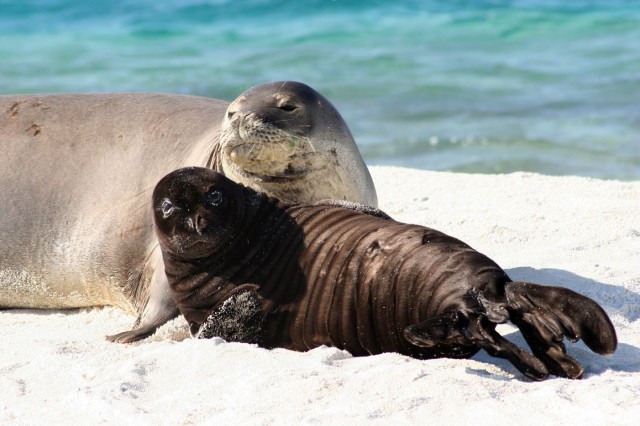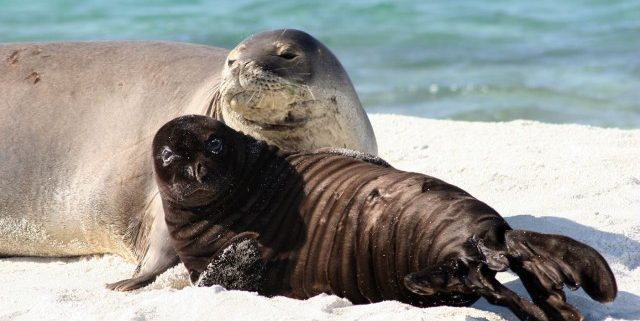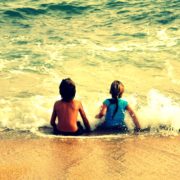Kauai Monk Seal Pups

Hawaiian Monk Seal and Pup
Springtime is Monk Seal pupping season. So far in March of 2013, at least four seals have been born in the Hawaiian Islands, although there still may be some unknown births in the remote areas of the Northwestern Hawaiian Islands. While no seals have been born on Kauai yet this year, a representative from the NOAA Monk Seal Research office expects that some of the female monk seals will pup here later this year. On average over the last few years, about four pups have been born on Kauai each year and Poipu Beach seems to be one their favorite locations for pupping.
While this event brings awe and wonder to visitors, it can also be a little dangerous for the pups if precautions are not taken. Luckily, Kauai has quite a devoted group of Monk Seal Watch Volunteers. You may see the yellow tape strung up around the Monk Seals to protect them. The volunteers are a wealth of knowledge, so don’t be afraid to ask them question. As long as you are standing on the outside of the tape, you can get some beautiful photos of a species that you will encounter nowhere else on earth.
If you get to see a Monk Seal pup, consider yourself lucky. The Hawaiian Monk Seal is one of the most endangered animal species on the planet. It is estimated that there are fewer than 1100 individuals in the population and while their population is increasing in the Main Hawaiian Islands, numbers are still declining in the Northwestern Hawaiian Islands. There are a number of conservation efforts underway to help curb this decline in population. To learn more about these efforts, you can visit the NOAA Monk Seal Research Program website.
You can help protect Hawaiian Monk Seals by learning more about them, following safe wildlife viewing guidelines and reporting any entangled marine life to: Marine
Mammal Stranding and Entanglement Hotline 1- 888-256-9840. Responsible wildlife viewing helps to ensure your safety and their protection and long-term
survival in the wild.
To ensure that your presence does not disturb Monk Seals you can practice the following responsible viewing guidelines:
Observe them from at least 50 yards. Since this is not always possible on the small beaches that we share with them, make sure to stay behind the yellow tape that has been placed around them for their safety.
Do not attempt to approach a seal or “play” with them. The seals may misinterpret your actions and cause serious injury. Cautiously swim back to shore and watch them from a safe vantage.
Do not attempt to push seals back in the water. Please keep your pet on a leash at all times when in the presence of monk seals. Dogs can share diseases with seals that could have devastating effects on the population.
Cautiously move away if you observe any of the following behaviors:
- Rapid movement away from the disturbance and toward the water.
- Sudden awakening from sleep on the beach.
- Female attempting to shield a pup with her body or by her movements.
- Vocalization or “growling” at the disturbance.
NOAA Monk Seal Research Page



